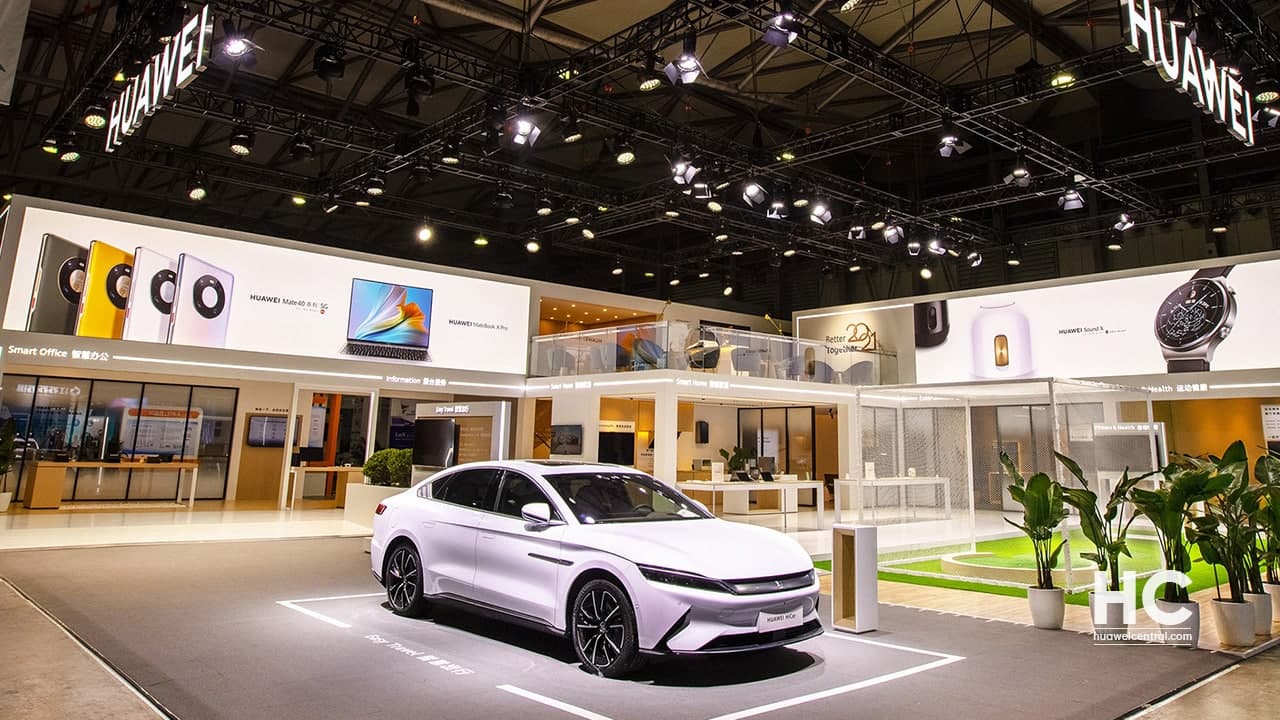Technology
Huawei Smart Car Technologies: Hongmeng OS, HiCar, In Car Smart Screen, Car app ecosystem, partnerships and more
Mobile World Congress Shanghai (MWCS) 2020 was suspended due to the pandemic but the advancement in technology didn’t stop. This year, the MWCS kicked off with the theme of Harmony and Symbiosis and there are over 500 exhibitors participated in this event to showcase products and technologies in the field of 5G, Internet of Things (IoT), Artificial Intelligence (AI), big data and more.
Automotive is also one of the most popular fields in this exhibition and during the keynote speeches, the 5G Automotive Alliance (5GAA) will hold a C-V2X technology forum.
At the event, Huawei will exhibit communication solutions and whole-house smart solutions, and the company has already planned really big for this event and the booth area of a Huawei manufacturer is very large, and two of the four venues have Huawei’s presence.
This proves that Huawei’s position in the global mobile communications field is very stable. Furthermore, the cars first came to the Huawei exhibition area at 2021MWC to explore the automotive technology exhibited by Huawei.
Huawei has the largest exhibition area:
Huawei exhibited smart solutions for the whole house in the exhibition hall, ranging from a light in the home to a TV, a refrigerator, and even a car in the home, all of which can be linked to each other, and the “garage” in the home. There were also a BYD Han and Huawei in-vehicle smart screen for the after installation market.
Both products work simultaneously with Huawei phones and can use the HiCar mapping system in the car.
HiCar in Smart Car solutions is very important, and it is an important piece for Huawei’s consumer business group to enter the automotive field. Last October, Huawei announced at a press conference that the number of HiCar pre-installed cars this year will reach 5 million units. In the domestic market, it can directly challenge Apple CarPlay.
What’s the Huawei HiCar experience and its role in modern technology?
There are a number of perspectives that you should aware of to understand the HiCar system.
1. First-gen HongmengOS has 29 apps support for Car:
Once you enter the car, the HiCar in the Huawei phone will start to work and automatically connects to the car’s system and its main interface of HiCar. The most intuitive experience of HiCar is familiarity and the entire interface is almost the same as the smartphone including the icons, user interface, and animations.
HiCar brings you a smartphone-like experience:
HiCar mobile mapping system can be connected by wired or wireless wired or wireless means. All calculation-related work is done on the mobile phone, and the car screen is only used for display.
Currently, the operating system of Huawei HiCar is Hongmeng OS 1.0 (HarmonyOS). According to the on-site staff, HiCar is developed based on Linux. After updating to Hongmeng OS 2.0 in the future, the features and experience will be more powerful.
After upgrading to Hongmeng OS 2.0, Huawei may allow more powerful devices such as tablets and PCs to be connected to the car system. The system has a big room for improvements in terms of computer power itself, so we can expect even more from the HiCar in the future.
The main interface of HiCar is composed of multiple card-like widgets, which display recommended applications and scenes. For example, we use a Huawei mobile phone to search for the address of a tourist attraction at home and start navigating. HiCar is automatically mapped to the car when we walk into the car, and the car will promptly continue the previous navigation.
Huawei HiCar supports AutoNavi and Baidu map navigation. In terms of real-life experience, the navigation operation is relatively smooth, whether you use voice navigation or the zoom in and zoom out of the rotating map, there is no lag. It is foreseeable that maybe a few years later, high refresh rate screens will also make their way to smart cars.
HiCar for various scenarios:
Not only navigation, but HiCar also takes a good car of entertainment. The system provides a card-type widget with shortcuts for linking with family and sets the Away from Home mode on the mobile.
Swipe up on the widget page to find more HiCar-supported apps. In the HiCar app store of the mobile, you can also download additional apps that support the HiCar mapping system, covering multiple categories of apps such as maps, music, audiobooks, news, games, and children’s entertainment.
Huawei HiCar App Store:
As of now, the HiCar App Store supports 29 applications and the number of apps is still expanding. Among these apps, the most common ones include audio-visual entertainment software, which works along with the entertainment system that comes with BYD Han cars.
For now, the HiCar app ecosystem is not completed but there’s more to come.
News applications have a relatively high degree of completion and are worthy of praise. For example, after opening NetEase News, there are more large-size headlines, and the news is played directly by voice. The experience is very convenient.
Voice Assistant:
The HiCar system also supports Huawei Voice Assistant Celia. If there’s a need, just call Hey Celia, and it can help you to resolve various operations such as checking addresses, making calls, playing music, and more.
In China, Huawei is targeting Apple CarPlay. The solutions for these two cars are mapping systems, and the calculation is done on the mobile phone. Compared with CarPlay, Huawei’s HiCar localized application is obviously better, with numerous applications supported, and it also supports both wired and wireless connection modes.
CarPlay is different. Many car companies do not provide wireless CarPlay. It is indeed more troublesome to connect the power cord.
In addition, Apple’s CarPlay and car companies have limited cooperation depth, so they can only control cars at the software level. On the other hand, Huawei has more in-depth cooperation with car companies. The smart voice assistant can directly control vehicle hardware, which is a deep-rooted integration.
There are many cars in the market, Four key points to remember:
Huawei HiCar system is currently integrated into BYD Han cars but a recent report reveals that Huawei has reached cooperation with more than 30 car maker companies, including Volvo, BAIC, SAIC, GAC, FAW, Great Wall, BYD, Geely, Changan, etc.
Last year, Huawei announced that it plans to pre-install Huawei HiCar in more than 5 million new cars this year. Whether this goal can be achieved depends on the software service in the car. If commonly used apps can be installed and the experience is good, coupled with the huge base of Huawei mobile phone users, automakers will have a strong desire to pre-install HiCar.
150 Cars will be pre-equipped with Huawei HiCar:
The process of developing HiCar is focused on four “S”, so as to make the owner feel more comfortable.
1. Safety. Safety is the foundation of automobiles. For automobile manufacturers, it is already the bottom line to meet the requirements of software and hardware safety certification for mass production.
2. Smart Connection Smart connection. HiCar supports wired and wireless connections and is smart in hardware. When connecting wirelessly, you only need to enter a password and Bluetooth will pair.
3. Seamless Experience Seamless experience. This is the strategy adopted by Huawei in the entire smart home solution, as far as possible to let people feel the consistency and continuity of the product experience in the process of using the product.
4. Resource Sharing Resource Sharing. This key makes HiCar more usable. For example, when the GPS signal of the mobile phone is insufficient, the vehicle will give priority to the positioning of the car machine signal to ensure that “who uses the force” is guaranteed. This is probably not possible by other mobile phone system mapping manufacturers.
It is precise because of these four keys that Huawei HiCar has the confidence to achieve 5 million pre-installed units.
3. Huawei Car Smart Screen:
Huawei’s car smart screen is almost identical to BYD Hanzhong’s HiCar and it is very suitable for users who don’t want to change cars but want a complete HiCar experience.
Whether it is connection or control, Huawei’s own products are smoother. Except for the slightly smaller screen of only 8.9 inches, the overall experience of Huawei’s car smart screen is very good.
It should be noted that Huawei’s in-vehicle smart screen cannot be used alone, and it must be used with Huawei phones. Huawei’s car smart screen uses a 1920 x 720 resolution screen with a PPI of 230. The screen material is an IPS screen with a maximum brightness of 700nit. In sunny daytime, the screen will not be invisible.
There is a small speaker on the base of the car smart screen, which can play audio. There are two microphones at the bottom of the screen, which is used to wake up the voice assistant and voice calls.
There is a driving recorder camera behind the screen, which can record the trajectory of traffic in real-time. This camera is an ultra-wide-angle camera with a diagonal of 135 degrees and can record 2K resolution video. On the front of the screen, there is also a pop-up camera that can make video calls in the car. The resolution is 1080P and the diagonal angle is also an ultra-wide angle of 135 degrees.
At the same time, Huawei’s in-vehicle smart screen can rotate around 360 degrees and pitch angle rotation, which is convenient for the main driver and co-driver to watch content.
However, for after-installed models, the wiring method of the power cable in the car and the audio output are both problems.
Conclusion:
In 2020, Huawei Automotive BU officially released the HI brand. In the future, Huawei’s automotive solutions will enter the field of vehicle manufacturing.
This is believed to be the second “Bosch” in the automotive industry. At the same time, Huawei’s consumer business BG is also running on the car, HiCar has achieved pre-installed mass production, and HMS for Car officially announced that it will be equipped with the new Mercedes-Benz S-Class.
Obviously, the automotive ambitions of Huawei’s consumer business are not small, do you want to become the second “Android” in the automotive industry?
This year, Huawei has planned to drive more into the field of car technologies and rapidly developing in-vehicle solutions as well as smart cockpits. The Chinese tech giant is also accelerating the world of smart cars with its latest technologies.








